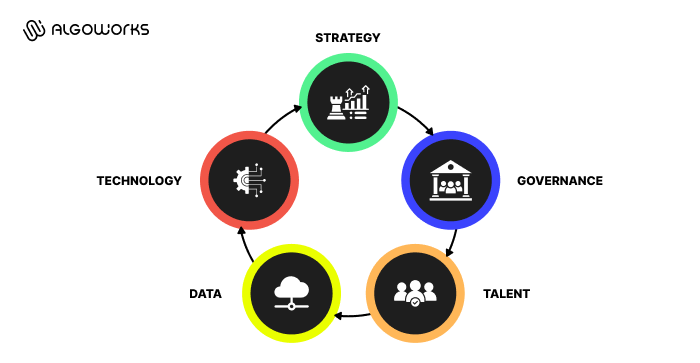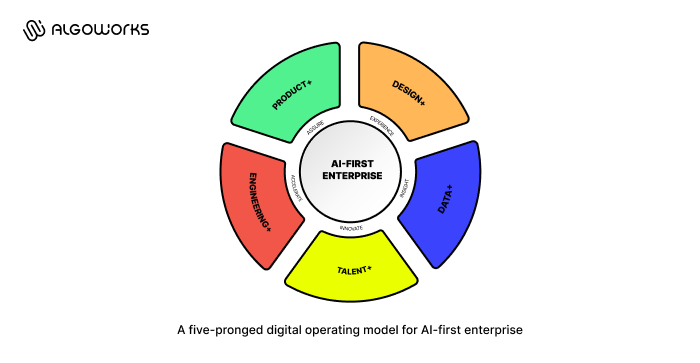Is your Salesforce strategy blocking your AI future?
AI is no longer something you can afford to “wait and see” on. It is here, it’s moving fast and Salesforce AI strategy isn’t sitting still. Between Data Cloud, Copilots and Agentic AI, they have made it clear that AI is baked into the future of the platform.
So, if you are already on Salesforce, you should be ahead of the curve, right?
Then what is the real issue? Well, most companies are not behind because AI is too new. They are behind because their Salesforce setup was never built to support it.
If your Salesforce AI strategy is rigid, cluttered or just stuck in 2018, then AI won’t take off. You are not just blocking AI; you are blocking your own future growth.
Let’s talk about what is really holding teams back and what an AI-ready Salesforce environment actually looks like.
The AI opportunity is real
You have probably seen AI being used in product demos, sales pitch decks or Salesforce webinars. Maybe your team even ran a pilot or integrated a few AI features here and there.
Meanwhile, companies outside your organization are qualifying leads faster, resolving support tickets in minutes and personalizing marketing at scale. How is all this possible? Well, AI real and its impact is visible right now.
Although, fiddling with AI is not the same as being AI-ready. If the foundation is not strong, none of the tools will stick. Which brings us to the read question:
Is your Salesforce strategy actually AI-ready?

It is very hard to put advanced AI into a system that was never built to support it. Hardly 2% of organizations are fully AI-ready, and the roadblocks for others usually fall into two categories, structural and behavioral.
Structural blocks
These are the system-level flaws that quietly kill every Salesforce AI strategy you build. Even when the interest is there, some very real constraints slow down adoption:
- Data Cloud costs are often higher than what teams expect, making CFOs cautious before greenlighting AI integration. This is why many teams now start with embedded “Everyday AI” use cases, which deliver immediate wins without large up-front platform costs.
- Data chaos: Customer data is fragmented across teams and tools. And for AI to work properly, you need clean and connected data. If you want better AI performance start by teaching your data to think.
- Agentforce ROI is still unclear for many businesses. Without upfront alignment on business objectives and ROI metrics, the value gets lost in experimentation. Teams that define these before implementation see adoption move much faster.
- A shortage of in-house Agentic AI skills means even willing teams don’t have the internal muscle to execute confidently.
Behavioral blocks
People are also a problem, just as harmful as the system and often very hard to fix. Here’s how:
- Your team can’t explain how AI decisions are made.
- You’ve run AI pilots but never gone beyond testing.
- You’ve invested in AI tools but can’t point to actual business wins.
- You don’t even know where your key customer data actually lives.
- Your workflows were built for 2018 and haven’t evolved.
These issues are hardly visible in the reports, but they kill the Salesforce AI strategy momentum fast. So, what is the opposite of this? Ask yourself:
What does an AI-ready Salesforce setup actually look like?
Once you clear the clutter, here’s what a modern, Salesforce AI strategy should be built around:
Composable by default
The architecture should feel more like LEGO and less like locked-in software. Every part of the system, i.e., apps, data, workflows; should be modular, replaceable and extendable. Composable design allows your team to experiment, ship faster and plug into AI services without waiting on six-month dev cycles or massive rework.
Data cloud + zero copy access
AI runs on data but not if your data is siloed, duplicated or locked in disconnected systems. With Salesforce’s Data Cloud you can unify customer profiles across channels without copying or moving data around. Zero-copy architecture means AI models will get cleaner, faster access to the data they need.
Pattern-driven, not pilot-obsessed
If you treat every AI use case as an experiment, you will stay stuck in an endless pilot loop. Meanwhile, high performing Salesforce development companies build AI into their workflows by design. That’s a real Salesforce AI strategy, not a scattered set of pilots.
Agentic mindset
AI copilots and autonomous agents are not there just to assist, they initiate, recommend and act according to the need. That shift in mindset is critical to any working Salesforce AI strategy. But this is possible only if your organization is ready to hand over certain decisions.
How smart CEOs are leading this shift
- They build internal AI maturity models with clear stages and clear benchmarks. In other words, everybody knows where they are and what’s next.
- AI becomes the ROI upfront from day 1. If the model is not saving any money, they do not launch it. Outcome is the major focus not just the presence of AI.
- They treat AI enablement as infrastructure not just a random feature. It is not a department; it is baked into how the business runs similar to DevOps or security.
- AI is not just one team’s job; it has a cross-functional role. Just like how data, ops, security, CRM and business owners are one unit.
How to fix the gap before it widens?

AI-first enterprises have a model that prefer to have a shared digital infrastructure and here is how you can fix the gap in the infrastructure:
Step 1: Audit your organization
Begin by mapping your existing workflows, data flows, AI usage and Salesforce integration points. The objective is to develop a clear picture oof how information is moving across your organization. Find out where bottlenecks exist and which components are limiting AI performance.
Step 2: Realign on value
Don’t start with a wish list of AI features; start with business outcomes. This is where “Everyday AI” comes in; making AI so embedded in daily workflows that its value is felt in weeks, not years.
For example, in a recent DWK discovery sprint, we mapped 40 potential AI ideas in just two weeks. Of those, 13–18 had a clear ROI path and were ready for fast-track implementation. That clarity keeps AI momentum alive while the bigger, architectural changes take shape.
Step 3: Re-architect where needed
Another possible obstacle is outdated system design and if your current architecture is built around manual process, it can be a problem. You might need to restructure the system, introduce scalable data models or provide flexible AI workflows. Read about the top Salesforce trends to enhance business with AI automation. This can inform how your Salesforce AI strategy evolves from here.
Step 4: Train your agents
Now whether you are deploying Salesforce Copilot, third-party assistants or custom models, train the agents properly. This includes feeding clean and structure data. This will allow them to handle the context and apply it in the business process properly.
Final take: Evolve or be outpaced
The gap between teams that experiment and teams that operationalize AI is getting wider and fast. At Algoworks, we are helping companies get their Salesforce AI-strategy ready the right way.
We’re bringing these conversations to Dreamforce 2025. Meet our team at Algoworks Commons, our dedicated space for hands-on discussions, working sessions and private consultations on AI readiness.
Request a meeting with our team at Dreamforce.
FAQs
Is Einstein enough to make my org AI-ready?
No, not on its own. Einstein brings powerful capabilities like predictive scoring, automation and generative AI copilots but it depends heavily on your data quality and process design. If your Salesforce instance is misaligned or your data is scattered, Einstein won’t perform as expected.
What’s the difference between Data Cloud and a regular CDP?
Data Cloud is built into Salesforce and connects real-time, structured and unstructured data across systems; unlike a CDP that’s mostly focused on marketing.
How long does AI readiness take?
It depends. With the right foundation, you can start seeing results in weeks. However, full readiness usually takes a few months of focused work.
Do I need Data Scientists or just better Salesforce admins?
You need both; but you don’t need a huge data science team. Strong Salesforce admins who understand prompts, flows and data models can drive a lot of impact.
What’s “Zero Copy” in plain English?
It means Salesforce can read and use data where it already lives without duplicating it or moving it around. This is a faster, cleaner and cheaper process.
